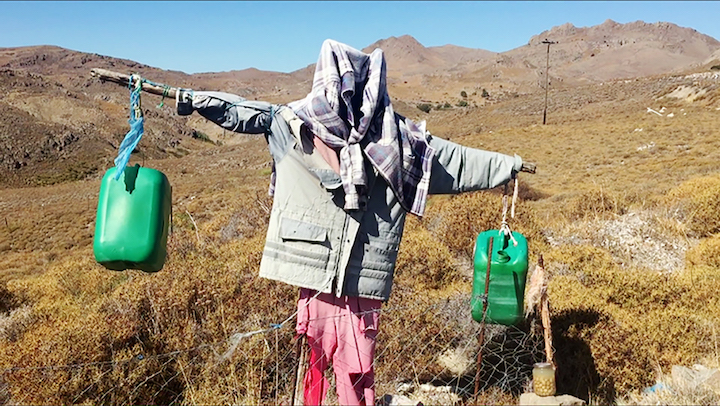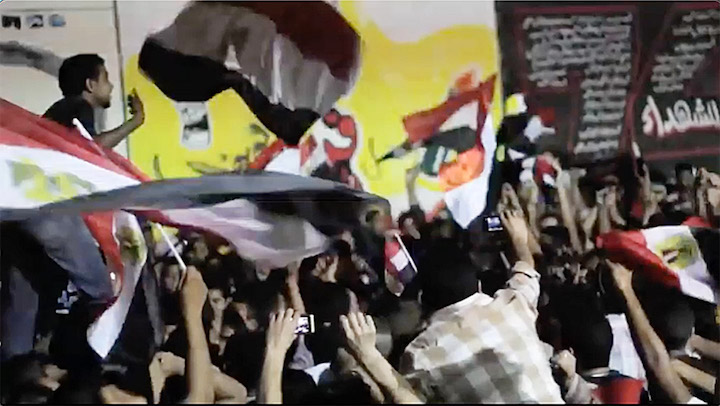Monday May 2 – Thursday May 5, 11pm PT
Call of the Wild
Organized by Sherry Millner & Ernie Larsen
Works by John Greyson, Jorge Furtado, Birgit Hein, Sherry Millner & Ernie Larsen, Mosireen Collective, Olga Poliakoff & Yann Le Masson
Q&A with the organizers
In Person & Online

Microscope is very pleased to present “Call of the Wild,” an evening of six experimental non-fiction films made in six countries, organized by New York-based artists and curators Sherry Millner & Ernie Larsen.
The program of works — made between 1961 and 2021 — by Jorge Furtado (Brazil), John Greyson (Canada), Birgit Hein (Germany), Sherry Millner & Ernie Larsen (US), Mosireen Collective (Egypt), Olga Poliakoff & Yann Le Masson (France/Algeria), features a range of subject matter and approaches described by the organizers as:
A global chorus, a lament, the drawings and voices of traumatized boys, a comic rant, pigs and the poor rooting in a garbage dump, the moon as a migrant squat, gorillas, birds, and teddy bears. The absolutely crucial moment at which a mere call suddenly or gradually transforms into a wild unrestrained demand for freedom ties this highly diverse program of experimental political nonfiction films together. — SM & EL
The screening and Q&A with the audience will take place both in person and online.
In-person General Admission $9
In-person Member Admission $7
Online Tickets will be available starting at 7:00pm ET on Monday May 2nd on this page.
Please note: Proof of vaccine & masks are required at this time for in-person events.
_
Sherry Millner & Ernie Larsen collaborate on film, video, photo-text, book, curatorial and other research projects. Together they have produced at least a dozen films exhibited in festivals, museums, cultural centers, squats, windows, and storefronts. Millner creates installations such as The Domestic Boobytrap, which detournes diagrams in U.S. army manuals to manifest the vulnerability of domestic space, with blueprints and models of boobytraps placed in everyday life situations within the nuclear family. She has also produced many series of photomontages. Images from one current series, Border Triptychs, adorn an essay/assemblage titled “Flipping A Coin” Larsen has published, in three parts, in e-flux conversations. This essay explores the conditions of the No Border events in Thessaloniki, Greece in 2016. Larsen writes fiction (his novel, Not a Through Street, was nominated for an Edgar Award) and media criticism. His book The Trial Before The Trial, an account of his experiences while serving on a special narcotics grand jury in New York, explores and deplores the justice system’s racial disparities. He and Sherry are associate editors of the media journal Jump Cut.
John Greyson is a film artist of the new queer cinema. His films include MURDER IN PASSING, FIG TREES, LILIES, ZERO PATIENCE and URINAL, and have received 40+ awards at such festivals as TIFF, Locarno, Lisbon, Ann Arbor, as well as 3 Berlinale Teddies and 5 Canadian Screen Awards.
Jorge Furtado (Porto Alegre, 1959), a partially self-taught Brazilian filmmaker, studied medicine, psychology, journalism and plastic arts, without finishing any of his studies. After working on television in the 1980s, he created the production company Luz Producciones and made his first two short films. In 1987 he was one of the founders of the Porto Alegre Film House. Among his works, Ilha das Flores stands out, which received numerous national and international awards, among them the Best Short Film at the Berlin Festival. He has also made two feature films: Houve uma vez dois veroes (2002) and O homem que copiava (2003), both winners of national awards.
Birgit Hein (born August 6, 1942) is a German film director, producer and screenwriter who has made experimental films with her husband Wilhelm Hein since the 1960s. Hein was born in Berlin in 1942. In 1964, she married Wilhelm Hein, with whom she collaborated on several experimental film projects. In 1968, she co-founded XSCREEN, an exhibition space in Cologne. In 1993, Hein won the German Film Critics Association Best Experimental Film Award for her film Die Unheimlichen Frauen.
Mosireen is a volunteer media activist collective that came together to document and transmit images of the Egyptian Revolution of 2011. Between 2011 and 2014 the collective produced and published over 250 videos online, with a focus on street politics, state violence and labour rights. They have been watched over six million times on YouTube; re-broadcast and re-mixed countless more. As well as video production, Mosireen organizes street screenings, educational workshops, production facilities and campaign support. After the military coup of 2013, their work as a collective has been narrowed to the organization and publication of a large collection of video material from the revolution, fully under Creative Commons. “858: An Archive of Resistance” was published in January 2018.
Olga Poliakoff was born on May 5, 1928 in Pancevo, Serbia, Yugoslavia [now Serbia]. She was an actress and assistant director, known for her appearances in “The Unbearable Lightness of Being” (1988) and “Days of Love” (1954), and for her film “J’ai huit ans” (1962), among others. She died on September 2, 2009 in Villejuif, Val-de-Marne, France. Yann Le Masson (1930-2012) was a talented cameraman and militant filmmaker. Le Masson is the co-founder, in 1974, with Jean-Michel Carré and Serge Poljinsky, of the production collective Grain de Sable. His films include “J’ai huit ans” (1961), “Sucre amber” (1963), and “Kashima Paradise” (1973), among others.

Program includes:
International Dawn Chorus Day
John Greyson, Canada, 2021, 17 minutes
Shot during the pandemic with 40 artists and filmmakers from six continents waking up early on May 3, 2020 to shoot/record their respective dawn choruses on their cellphones. A Zoom call visual grid offers a bird song for Egyptian filmmaker Shady Habash and Egyptian queer activist, Sarah Hegazi, who lost their lives enduring the horrors of wrongful detention. Shady Habash was known for his satiric anti-dictator music videos and Egyptian queer activist Sarah Hegazi was notoriously incarcerated for flying a rainbow flag at a Cairo concert. World premiere at Berlinale 2021 where it won the Teddy Award for Best Short Film. John Greyson is a key director in both the Toronto New Wave and the New Queer Cinema movements.
J’ai Huit Ans/ I Am Eight Years Old
Olga Poliakoff & Yann Le Masson, France/Algeria, 1961, 8 minutes
Secretly filmed in a refugee camp in Tunisia across the border from Algeria, banned for twelve years in France, this intimate documentary captures the trauma of the Algerian War as suffered by nine boys. Their drawings translate their wartime experiences to vividly portray the daily brutality of colonialist rule. Frantz Fanon pioneered the therapeutic approach in the camp that emphasized the crucial role of the boys’ image-memories in articulating their viscerally fragmented understanding of the ceaseless barrage of the French forces. Activist filmmaker Rene Vautier developed the scenario at Fanon’s urgent suggestion.
How Do Animals and Plants Live?
Millner & Larsen, U.S., 2021, 29 minutes
An inquiry into the forcible eviction and demolition of the self-organized anarchist-supported migrant squat Orfanotrofeio in Thessaloniki, Greece, in July 2016. An interview with a young West African migrant amid the bulldozed ruins of the old orphanage, performative translations from the Greek-language children’s schoolbook How Do Animals and Plants Live? that the filmmakers found amid the rubble when they broke into the ruined site—these and other elements (teddy bears, birds, a tied-up calf) are interwoven with unexpected visuals sparked by questions translated directly from the book, questions without real answers. Visuals that pointedly wonder: how is this possible? Asserting in four languages that “no one is illegal,” the visual essay valorizes the migrants’ self-organization, autonomy, solidarity, assembly, and direct action, at an historical moment when the status of the refugee has become and will remain a global paradigm.
Prayer of Fear
Mosireen Collective, Egypt, 2013, 4 minutes
Amidst the Egyptian Revolt of 2013. Subjective flashes of street warfare and an unnamed woman plunging ahead as she recites a Mahmoud Ezzat poem, a lament for the victims of the clashes and massacres in and around Tahrir Square, forced by circumstances to question the value of martyrdom. The Mosireen Collective galvanized citizen media in the wake of President Mubarak’s fall, producing hundreds of searing videos, recently assembled into an archive of 858 hours.
Isle Of Flowers
Jorge Furtado, Brazil, 1989, 12 minutes 36 seconds
Hailed as a masterpiece by Chris Marker and described by Furtado as a “letter to a Martian who knows nothing of the earth and its social systems,” the film uses inventive animation, a parodic mock-lecture style of narration, actors, and a corrosive conceptual structure, to link the urban bourgeois family to the rural poor who scavenge the garbage dump, the ‘isle of flowers,’ where pigs eat better than people.
Jack Smith
Birgit Hein, Germany, 1974, 10 minutes
At a zoo in Cologne, the legendary performer/filmmaker/song stylist Jack Smith writes checks to gorillas and then, garbed in an elaborately feathered head-dress, expounds on the evils of museum culture and the exploitation of art by the rich. Smith insouciantly denounces the patronage system’s reduction of the artist not to the status of a wild animal captured in a zoo but to the despicable dependence of a neglected pet. Rare screening (Sacklers not invited)!

_
Microscope’s Event Series 2021-22 is sponsored by Re:Voir, a home video label for classic and contemporary experimental film in Paris, France.

